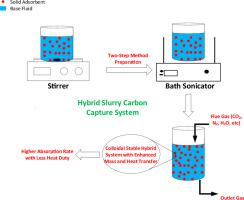International Journal of Greenhouse Gas Control ( IF 3.9 ) Pub Date : 2021-07-24 , DOI: 10.1016/j.ijggc.2021.103415 Hassan A. Salih 1 , Jeewan Pokhrel 2, 3 , Donald Reinalda 2 , Inas AlNashf 1, 2 , Maryam Khaleel 1, 2, 4 , Lourdes F. Vega 1, 2, 4 , Georgios N. Karanikolos 1, 2, 4 , Mohammad Abu Zahra 1, 2

|
The mitigation of carbon dioxide emissions using hybrid-slurry systems evolved over recent years as an alternative for conventional processes for CO2 capture. The hybrid systems capture CO2 by both of adsorption and absorption processes. Generally, this review discusses the concept, provides illustrations, preparation techniques, transport mechanisms and separation performance for different slurry systems found in the literature. Various slurry/nanofluid systems were screened to identify their gas separation performance based on gas uptake (amount and rate), sorption and desorption enthalpy and kinetics as compared to chemical absorption processes. The hybrid systems are categorized as aqueous, amine, alcohol, ionic liquid, Nanoparticle Organic Hybrid Materials (NOHMs), and enzymatic based. Various solid adsorbents are suspended in these solvents include carbons, zeolites, metal oxides, metal organic frameworks (MOFs) and Zeolite Imidazolate Frameworks (ZIFs). Overall, the slurry systems provide some strengths represented in lower regeneration energy and enhanced mass transfer by different mechanisms. On the other hand, the application of hybrid-slurry systems is challenged by different limitations such as material cost, pumping difficulty, wearing and erosion, phase stability, and solvent degradation. These challenges require proper addressing and tackling to move the hybrids towards large scale applications.
中文翻译:

混合——浆液/纳米流体系统作为二氧化碳捕获的传统化学吸收的替代品:综述
使用混合泥浆系统减少二氧化碳排放是近年来发展起来的,作为传统 CO 2捕集工艺的替代方法。混合系统捕获 CO 2通过吸附和吸收过程。一般来说,这篇综述讨论了这个概念,提供了文献中不同浆料系统的说明、制备技术、传输机制和分离性能。与化学吸收过程相比,基于气体吸收(量和速率)、吸附和解吸焓和动力学,筛选了各种浆液/纳米流体系统以识别它们的气体分离性能。混合系统分为水性、胺、醇、离子液体、纳米粒子有机混合材料 (NOHM) 和基于酶的。各种固体吸附剂悬浮在这些溶剂中,包括碳、沸石、金属氧化物、金属有机骨架 (MOF) 和沸石咪唑酯骨架 (ZIF)。全面的,浆料系统提供了一些优势,表现为较低的再生能量和通过不同机制增强的传质。另一方面,混合浆料系统的应用受到不同限制的挑战,例如材料成本、泵送困难、磨损和侵蚀、相稳定性和溶剂降解。这些挑战需要适当的解决和处理,以将混合动力推向大规模应用。


























 京公网安备 11010802027423号
京公网安备 11010802027423号